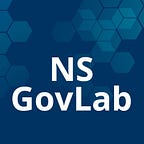By: Jocelyn Yerxa (Director, NS GovLab)
“Have no fear of perfection — you’ll never reach it.” — Salvador Dali
Prototyping is becoming a very popular thing to talk about, but what is it?
At its core, prototyping is about experimenting and learning. Prototyping allows us to see how people respond to different approaches to transforming systems.
Prototyping has a few key steps (explained in more detail in Sourcebook). An important step is framing the challenge — deciding what it is you want to focus on and learning more about it.
It might be helpful to frame the challenge as a question. Asking “How might we…?” can support a broad range of solutions.
Another step is exploring and engaging — doing research and gathering information from those experiencing the challenge you are curious about. Working ethically is critically important.(IDEOS’ Little book of Design Research Ethics is a great tool: IDEO 2015). The insights and observations you make while exploring the challenge will give you a better understanding of the challenge.
Interviews and observations help test your assumptions and your “How Might We…” question. Making sense of this research as a group will help see the challenge from new perspectives. This will be the inspiration for your prototypes. Making sense of your research involves:
- sharing observations
- looking for themes/patterns
- identifying insights
- confirming or reframing the design question (Does “How might we…?” need to change to inspire new possibilities?)
It’s not unusual for people to feel like they don’t have enough information after initial exploration. Don’t let that stop you. Your purpose is to learn and you learn by trying!
Another step that gets a lot of attention in the innovation sector is ideation — the creative process of generating ideas. Ideation can help you:
- ask the right questions
- push beyond the obvious and increase the potential for new and better ideas
- bring together perspectives and strengths of the group
- uncover unexpected areas of innovation
- create a wider and more original range of options.
- get obvious solutions out of your heads and move beyond them
Your first ideas won’t be the best ideas. An ideation phase broadens your thinking and creates space to explore ideas that might seem unconnected. The key is to generate ideas quickly so you can test your assumptions and learn what might work and what won’t. You will go through many ideas. Ultimately, this will help you create more innovative and effective solutions.
Once you have brainstormed all your ideas, determine which one to try. Consider where each idea lands on the continuum of new and useful versus status quo and symptom and root cause. An idea is new and useful if it is fresh and meets peoples’ needs. A symptom is a sign of a bigger issue while the root cause is the underlying reason for the issue.
A strong idea is shaped by your best guesses of what the future could be, and how the idea might address the identified root causes. Consider the elements of ideas as some may be desirable and others not.
Prototypes enable the sharing of ideas to get feedback and refine them further. Anything can be prototyped. The key is making it real for people. Ways to do this:
Build it. Create a three-dimensional representation using paper, cardboard, Lego, modelling clay, pipe cleaners, Styrofoam, etc. If the idea is a digital tool or website, sketch the screens on paper and tape it to a computer screen or mobile device to test it. After getting initial feedback, create a digital version.
Act it out. Create a role play of the idea. Write up the roles and the situation and try on different roles to understand the experience from multiple angles. Consider assembling simple props to help people experience the idea more fully. Record it and play it for others to get their thoughts about your idea.
Draw it out. Tell a story using illustrations — a storyboard, journey map or diagram. Use words along with drawings to help describe the idea.
Remember, prototyping is about learning and getting feedback to improve ideas. Break down what you have learned to determine the most important elements to validate and the most important questions and assumptions to test. Then, think about the simplest and best prototype and make it real.
Finally, test your prototype. Feedback is not just verbal, but also reactions and how people interact with the prototype. Watch and take notes of questions, difficulties people encounter and their ease interacting with the prototype.
If your challenge is complex, you will face many unknowns and many possible paths to follow. As things change, adapt. As things emerge, adapt. Decision points may include abandoning, changing or persevering. As long as, change and complexity are embedded in systems, the response must adapt to meet them.
So, the next time someone says they are prototyping, they mean things are getting real!
